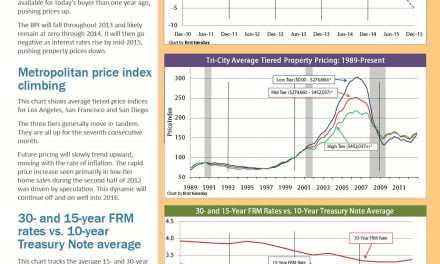This article identifies the growing contingent of foreign investors interested in purchasing California real estate and explains the basic investment strategy involved.
Should foreign investors in California real estate be incentivized by the federal government?
- No (77%, 60 Votes)
- Yes (23%, 18 Votes)
Total Voters: 78
Broader horizons
The current condition of the typical California real estate agent specializing in the sale of single family residences (SFRs) is in need of renovation. During the past five years, fees collected for successfully bringing ready, willing and able buyers and sellers together have declined steadily, resulting in annual incomes now hovering around 25% compared to boom-times.
Listings are in long supply, but homebuyers are scarce due to the dustbowl character of this jobless Lesser Depression. The few buyers that are trolling through the inventory enjoy the once-in-a-lifetime bargaining power that only the concurrence of low prices, low mortgage rates and scarce demand can offer. Thus, home prices in most locations are likely to slip a bit more, as SFR sales are caught in the liquidity trap of zero interest rates and locked-up demand. [For more information on sticky pricing, see the September 2009 first tuesday article, Price persistence and market illiquidity.]
Rather than attempting to squeeze blood from the turnip of California’s jobless, the savvy California real estate agent can tap the growing resource of the foreign investor. Foreign investors spent $82 billion on residential real estate in the U.S. last year, up 24% from the year prior. As the dollar is relatively weak compared to many other currencies, yet steadfastly remains a safe haven for investors to park their wealth, foreign investments in California residential real estate will continue to swell.
From yen to dollars then back
The U.S. is only at the end of the beginning of this Lesser Depression, and a number of other countries abroad are suffering as well (read: Greece, which is in a spot not entirely unlike California). Nevertheless, there are still great reserves of wealth to be had from other nations. Among those who stand to massage the U.S.’ current depression-like predicament to their advantage is Japan. Switzerland and China also quickly come to mind.
The simplest of all investment strategies apply for the Japanese investor: buy low, sell high. Japanese investors looking to go long on a foreign investment and park their wealth in the safe haven currency of the U.S. dollar are in the perfect position to do so by investing in California real estate.
The opportunities they are presented are twofold. Currently, the dollar is weak against the yen. Both currencies are running at essentially neutral interest rates (read: zero), thereby negating the potential for a traditional carry trade, which exploits differences in the relative interest rates affecting two currencies (Brazil’s real is an example of a strong currency paying a high rate of return, presently over 10%, while the U.S. dollar pays essentially zero). Thus the yen buys more dollars, allowing a Japanese investor to purchase greater quantities of dollar-denominated assets than at any time during the past decade.
The first key to this currency exchange duet is the bet that the dollar will inevitably strengthen against the yen as U.S. gross domestic product (GDP) begins to show recovery-style growth and the realities of the Japanese economy (read: negative population growth and a universal recognition that the yen is overvalued) drive the value of the yen down in relation to the U.S. dollar.
Both the Bank of Japan (BOJ) and the Federal Reserve (the Fed) are motivated to keep interest rates low with a modicum of inflation in order to maintain consumer confidence and to get their populations spending again. These matching monetary policies will continue into the near future, alleviating the substantial risk factors of interest rate or inflationary differentials eating up the investor’s return on investment (ROI) and nullifying the results of an exchange rate shift.
Thus, ROI for the basic yen/dollar foreign exchange market (FOREX) trade seems a safe bet for the Japanese investor with a little patience. All that is left to do is buy back his weak yen with his now strong dollars and profit is magically produced simply by exchange rates.
Why does the California real estate agent care?
When considering the investment strategy of this foreign investor, one question immediately comes to mind: where is he parking the dollars he acquired while waiting for the exchange rates to turn in his favor?
Typically foreign investors will park their wealth in low-risk instruments such as U.S. government bonds. The current yield on the 5-year T-note hovers around 1%, which when adjusted for inflation produces a negative real rate of return.
Is it a safe haven? Yes. Does it generate ROI above and beyond the return generated from a shift in the exchange rate? No. Enter California real estate.
In order to redouble ROI, a foreign investor might consider parking the dollars he acquired by exchange in California real estate. By doing so, the foreign investor first buys weak dollars in exchange for his relatively strong currency (yen in this example). With his dollars, he buys a sorely (historically) underpriced asset in California real estate. The real estate will inevitably appreciate over the long term, floating near the mean price denoted by the equilibrium trend-line in real estate pricing – the rate of consumer inflation. [For more information on the equilibrium trend line, see the October 2011 first tuesday article, The equilibrium trendline: the mean-price anchor]
Once the dollar appreciates against the yen, and after real estate prices pick back up, which they will at least at the target rate of inflation, the foreign investor can then sell their dollar denominated asset (the real estate) at a profit and then double-down on their ROI by exchanging their then-strong U.S. dollars for a weakened homeland currency.
Here is the stick, here is the carrot
As is now abundantly clear, no matter how hard the Fed tries to provide an environment ripe for domestic investment in California real estate, it is just not working. Interest rates remain essentially at zero (with a spread for setting mortgage rates), prices are about at the bottom in this vicious cycle and few users are competing to buy homes.
In an interview held earlier this year, Warren Buffet suggested that liberalizing the U.S. immigration policy by offering visas to well-heeled foreign investors would solve our financial ills rather quickly. Well Warren, Congress took your advice.
Multiple government subsidies and incentives are currently in place and new ones are cropping up as the government considers cashing in on the foreign demand for dollar-denominated assets — real estate. Between the EB-5 immigrant investor program and a recently proposed U.S. Senate bill, foreigners purchasing commercial or residential real estate in the U.S. stand to be handsomely rewarded for bringing their wealth to our shores. [For more information on the subsidies offered to foreign investors, see the July 2011 first tuesday article, Welcome to the Hotel California and the October 2011 first tuesday article Foreign investors have money, want real estate.]
Japan is only one source of foreign investors who stand to benefit from parking their wealth in California real estate; China will also play a significant part in California’s real estate market. Billions of dollars are being spent here by foreigners who have the money to spend and good reason to spend them on real estate.
Who is brokering these deals? Does the lion’s share once again go to Wall Street via real estate investment trusts (REITs) and private placements in limited liability companies (LLCs)? Or can the average California real estate broker tap this demand and collect the fees that otherwise go to the well-connected rentiers on Wall Street?
Get acquainted with foreign demand and make connections with their asset managers. Then, think syndication. [To read more about rentiers, see the September 2011 first tuesday article, Rentiers and debtors: why can’t they get along?; to learn more about syndication, see the first tuesday book, Forming Real Estate Syndicates, Third Edition.]














Fred Crane knows me well. I am here in Hong Kong, China. Currency experts predict usd will drop 40 % in next 3 years against the Hong Kong dollar and Chinese yuan. Does it make sense to buy US real estate unless you can make 40 % profit or more after taxes in 3 years. Of course, enhancing the value and leverage are other considerations in buying US real estate.
Cheers